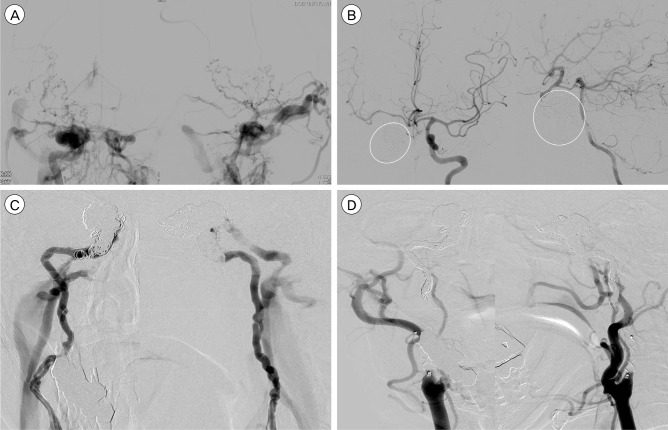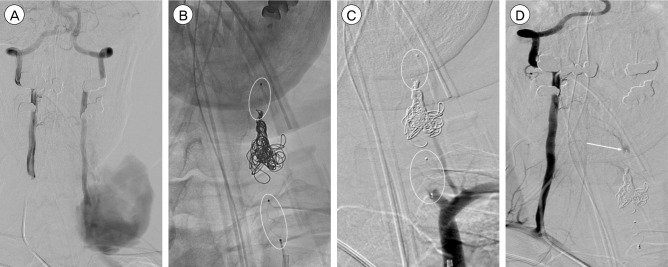J Cerebrovasc Endovasc Neurosurg.
2016 Sep;18(3):208-214. 10.7461/jcen.2016.18.3.208.
Preliminary Experience with Vascular Plugs for Parent Artery Occlusion of the Carotid or Vertebral Arteries
- Affiliations
-
- 1Department of Neurosurgery, Gangnam Severance Hospital, Yonsei University College of Medicine, Seoul, Korea. ns.joonho.chung@gmail.com
- 2Department of Neurosurgery, Seoul St. Mary's Hospital, The Catholic University of Korea, Seoul, Korea.
- 3Severance Institute for Vascular and Metabolic Research, Yonsei University College of Medicine, Seoul, Korea.
- 4Department of Neurological Surgery, Rush University Medical Center, Chicago, IL, USA.
- KMID: 2355643
- DOI: http://doi.org/10.7461/jcen.2016.18.3.208
Abstract
OBJECTIVE
The purpose of this study was to report the authors' preliminary experience using the Amplatzer Vascular Plug (AVP) (St. Jude Medical, Plymouth, MN, USA) for parent artery occlusion of the internal carotid artery (ICA) or vertebral artery (VA).
MATERIALS AND METHODS
Between September 2008 and December 2015, we performed 52 therapeutic parent artery occlusions (PAOs) by an endovascular technique. Among them, 10 patients underwent PAO of the carotid or vertebral arteries using AVPs. Clinical and radiographic data of these patients were retrospectively reviewed.
RESULTS
The devices were used for VA dissection that presented with subarachnoid hemorrhage (SAH) in five patients, traumatic arteriovenous fistula (AVF) in two patients, spontaneous AVF in one patient, recurrence of carotid-cavernous fistula (CCF) in one patient, and symptomatic unruptured giant ICA aneurysm in one patient. The devices were used in conjunction with detachable and/or pushable coils and in the extracranial segments of the ICA or VA. Complete occlusion of the parent artery was achieved in all patients. There was one intra-procedural rupture of the VA dissection during coiling prior to using the device.
CONCLUSION
Results from the current series suggest that the AVP might be used for therapeutic PAO in the extracranial segments of the ICA or VA.
Keyword
MeSH Terms
Figure
Reference
-
1. Dorenberg EJ, Hafsahl G, Andersen R, Krohg-Sørensen K. Recurrent rupture of a hypogastric aneurysm caused by spontaneous recanalization of an Amplatzer vascular plug. J Vasc Interv Radiol. 2006; 6. 17(6):1037–1041. PMID: 16778239.
Article2. Fidelman N, Gordon RL, Bloom AI, LaBerge JM, Kerlan RK Jr. Reperfusion of pulmonary arteriovenous malformations after successful embolotherapy with vascular plugs. J Vasc Interv Radiol. 2008; 8. 19(8):1246–1250. PMID: 18656022.
Article3. Hart JL, Aldin Z, Braude P, Shovlin CL, Jackson J. Embolization of pulmonary arteriovenous malformations using the Amplatzer vascular plug: successful treatment of 69 consecutive patients. Eur Radiol. 2010; 11. 20(11):2663–2670. PMID: 20574633.
Article4. Letourneau-Guillon L, Faughnan ME, Soulez G, Giroux MF, Oliva VL, Boucher LM, et al. Therasse E. Embolization of pulmonary arteriovenous malformations with Amplatzer vascular plugs: safety and midterm effectiveness. J Vasc Interv Radiol. 2010; 5. 21(5):649–656. PMID: 20346701.5. Mager JJ, Overtoom TT, Blauw H, Lammers JW, Westermann CJ. Embolotherapy of pulmonary arteriovenous malformations: long-term results in 112 patients. J Vasc Interv Radiol. 2004; 5. 15(5):451–456. PMID: 15126654.
Article6. Mihlon F, Agrawal A, Nimjee SM, Ferrell A, Zomorodi AR, Smith TP, et al. Enhanced, rapid occlusion of carotid and vertebral arteries using the AMPLATZER Vascular Plug II device: the Duke Cerebrovascular Center experience in 8 patients with 22 AMPLATZER Vascular Plug II devices. World Neurosurg. 2015; 1. 83(1):62–68. PMID: 23920294.
Article7. Milic A, Chan RP, Cohen JH, Faughnan ME. Reperfusion of pulmonary arteriovenous malformations after embolotherapy. J Vasc Interv Radiol. 2005; 12. 16(12):1675–1683. PMID: 16371535.
Article8. Ong CK, Lam DV, Ong MT, Power MA, Parkinson RJ, Wenderoth JD. Neuroapplication of Amplatzer vascular plug for therapeutic sacrifice of major craniocerebral arteries: an initial clinical experience. Ann Acad Med Singapore. 2009; 9. 38(9):763–768. PMID: 19816634.9. Ross IB, Bucius R. The vascular plug: a new device for parent artery occusion. AJNR Am J Neuroradiol. 2007; 2. 28(2):385–386. PMID: 17297018.10. Scott DA, Keston P, White P, Sellar R. Vascular plug for ICA occlusion in cavernous carotid aneurysms: technical note. Neuroradiology. 2008; 9. 50(9):795–798. PMID: 18542939.
Article11. Shankar JJ, Maloney WJ, Vandorpe R. Amplatzer vascular plug for occlusion of parent artery in carotid blowout with active extravasation. Interv Neuroradiol. 2011; 6. 17(2):224–227. PMID: 21696663.
Article12. Tapping CR, Ettles DF, Robinson GJ. Long-term follow-up of treatment of pulmonary arteriovenous malformations with Amplatzer vascular plug and Amplatzer vascular plug II devices. J Vasc Interv Radiol. 2011; 12. 22(12):1740–1746. PMID: 22115581.
Article
- Full Text Links
- Actions
-
Cited
- CITED
-
- Close
- Share
- Similar articles
-
- Angiographic Demonstration of External Carotid-Vertebral Arteries Anastomosis
- Anglographic Findings of Collateral Vessels in Cervicofacial Vascular Lesions with Previously Ligated Carotid Artery
- Multiple Carotid Artery Occlusive Diseases Treated with Staged Subclavian-carotid Artery bypass and Carotid Endarterectomy: Case Report
- Analysis of Anatomy and Hemodynamics of Carotid and Vertebral Artery in a Healthy Korean Population
- Endovascular Treatments of Traumatic Carotid and Vertebral Vascular Injuries



